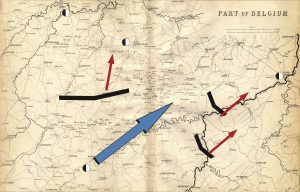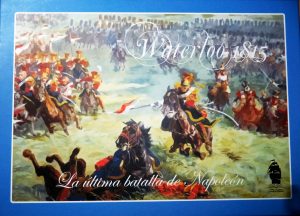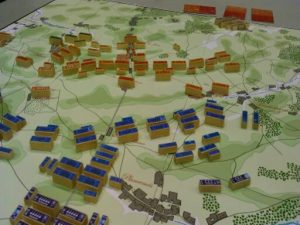WATERLOO 1815: THE LAST BATTLE OF NAPOLEON
Introduction:
Waterloo was the last battle of Napoleon. Is the culmination of them events that is develop during them "100 days", in which the Emperor French escapes of his captivity, and with it quickly that always you characterized, is capable of form an army huge and motivated, to face it to them Allied that, connoisseurs of its leak of Elba, decide invade France and finish with the Corso of a time by all. It is his last chance, he knows it and will run to face off against one and then another allied army, in order to defeat them one after the other. However the destination not him is conducive and the Eagle will fly for last time in Waterloo.

Image of the theatre of operations and plan general de Napoleon
The idea of Napoleon was, as quickly as possible, get immediate victories that forced their enemies to retract its supply centers, away from others and he penetrated by the fissure in both armies and end up with one and then the other. Allied supply centers were enormously distant; English in Brussels with origin in Antwerp, and the Prussian in Liège, on the way toward Namur. This opportunity should make it the most. The Russians would never come from their bases in Russia, one enemy less.
Those commanders:
- Napoleon: he certainly was a military genius and one of the best commanders of history. He was in possession of enormous charisma can inspire courage, devotion and loyalty without limits to his men, and impose its will on others, an inexhaustible energy and a huge capacity for work. Let us remember that in less than 7 hours wrote all orders in the campaign of Austerlitz from Boulogne when he realised that at Trafalgar he lost forever his plan to invade the damn British island. However his 46 years at the beginning of the campaign of 1815 he was not at his best, as he suffered from physical problems with serious consequences for their energy and physical and mental stability. Attributed to this fact that Napoleon commits errors tied impossible on it, such as underestimation of the enemy or delay of decisions at times critical of the battles, and transfer of command in absolutely incomprehensible moments at other times. And if this wasn't the worst, its staff was composed by generals that he chose and that military historians have considered to be one of the causes of the defeat of this campaign. Chose to Soult as Chief of State further instead of to Berthier or Suchet more capable and disciplined. For the left wing appointed to Ney, who the previous year had betrayed you swearing loyalty to the new King and forcing Napoleon to abdicate; as well as the impetuous and unthinking behaviour against a cold and calculating Wellington. To their right wing appointed Davout, Grouchy and not much more energetic and perfectionist as the first who leaves in rearguard illogically.
- Wellington: also of 46 years of age; excellent tactician, especially in defensive positions, great organizer and very meticulous, gave his troops of great discipline but of enormous pride that not granjeaban you no sympathy among his soldiers. In Exchange for Napoleon, Wellington could only choose to part of its staff: good general Hill who had fought in Spain along with him, and Delancey, great mayor. He rest you were tax: Maitland, Ompteda and Cooke, good general while the Prince of Orange was an inexperienced of 22 years, as well as the count of Uxbridge, his Lieutenant and Chief of its Cavalry, that Wellington hated by escape is with his sister-in-law.
- Blücher: the longest, 72 years old, but with an energy and a value without limits; Intelligent, impulsive, reckless and with enormous charisma that dragged to his men where outside necessary. Hated deeply to Napoleon, and this made is considered another point for the victory to the pawn is in reach in time for help to Wellington. It was Lieutenant Gneisenau, its counterpoint, because it was cold and cautious but brilliant, and however anglofobo, otherwise than his boss. This is crucial because if Blücher had perished in its load failed at Ligny, Gneiseau is doubted that it had maintained its head help the English word.
Hosts:
- Army of the North: In just two months, Napoleon manages to meet veterans and new cams that 128,000 men, do not exceed a number less than the masses of men of his Grande Armée, with a number less than members of the guard and in addition novices. However it was composed entirely by Frenchmen, huge moral, almost all were volunteers and were struggling to defend their own land, and obeyed very charismatic such as Ney and Napoleon leaders, which provided this army very different and powerful qualities even of enormous numerical inferiority against their enemies; so only 125,000 in combat over 350 cannons.
- Army Allied: one of their big problems is that was composed by a conglomerate of troops: British, belgaholandeses and German (Brunswick and Nassau) them troops more reliable were them British as were troops professional and veteran as well as the Legion German of the King (KGL), that occupied them areas of first line; However their allies were cam and novice of dubious capacity of endurance. In total, Wellington had with 106,000 men and 216 guns. However was very disseminated by the flank left French.
- Army Prussian: at the start of the campaign was very disseminated in a wide area by the flank right French: Wavre, Charleroi, Dinant, Liège and Maastricht. Included some 130,000 men and 280 guns.
The battle: 18 of June of 1815; Waterloo.
About 8 in the morning, Napoleon is situated about 2 km south of the Belle Alliance, la posada in lathe is displayed to which the French army. Discussing if Grouchy should provide support in the battle and make a battle of maneuver to outflank the enemy, but Napoleon chose a bloody confrontation: attack front.
After examining the battlefield and visible positions of Wellington (many after the hills that Napoleon could not see), this hotel offers accommodation in Rossomme farm 700 metres south of the Belle Alliance, which located its headquarters.

Image of the French deployment on 18 June 1815.
The French South of the allies occupied lofty positions with the first line in an Ene-OSO axis with the farm of La Belle Alliance in the middle of it.
On the right flank, front of Papelotte farm riders of Jacquinot, the 4th Division of Durutte, the 3rd of Marcognet, the 2nd of Danzelot with large number of artillery pieces, and immediately after the 1st Division of Quiot attached already to La Belle Alliance, beside the main road of Brussels. After the 3rd and 2nd Infantry divisions was the 4th body of cavalry, Milhaud and after them, the light cavalry of the Guard Division. After Quiot, the 5th Cavalry Division Subervie and 3rd of Domon. Further West stood the 2nd body of Reille: 5th Infantry Division of Bachelu, 9th Foy, pieces of artillery and in front of the granja-castillo of Hougoumont, the 6th Division of Jérôme Bonaparte, with more artillery. Finally the Cavalry of piré offer.
After Bachelu, is situated the brigades of Zimmer and Jannin of the 6 ° body of Lobau with its artillery. After Foy, the 3rd body of Cavalry of Kellermann.
Finally the reserve, the rest of the guard, i.e., the grenadiers of Friant and Morand (old guard and the Middle guard) hunters, shooters and acrobats from Duhesme (young guard), grenadiers stood in front of Rossomme farm horse, dragons and gendarmes of elite heavy cavalry of Guyot, and some artillery batteries.

Image of the deployment Allied on June 18, 1815.
The allies, on the right flank, to the West, the 2nd body of Hill (2nd Division of Clinton, brigade Mitchell of the 4th Div. Colville, with artillery. Behind them were the brigades of Halkett and Du Platt, of the 2nd Division of Clinton, with artillery)
In the Centre lining up the body I of the Prince of Orange and reserve units (Brigade Byng, Maitland and 1st Division of Cooke, with pieces of artillery. After them the body of Cavalry of Uxbridge, the 3rd Division of Alten, and the body of Brunswick after them)
In the book the 5th Division of Picton and after them Ponsoby with their dragons. To its side the 6th Division of Cole with his brigades Best, Lambert, Vincke, and ahead of them the Brigade of Saxe-Weimar of the 2nd Division belgaholandesa of Perponcher.
In total faced some 68,000 infants and 12,000 horsemen allies with 156 cannons against 86,000 – 72,000 French soldiers with 266 cannons. For the Prussian is estimated that appeared with 48,000 soldiers and 134 guns.

Image of the deployment of both sides on June 18, 1815.
Plan of battle:
The plan of Napoleon was simple; After glowing lines allied with a massive artillery bombardment, Ier Corps Derlon, cool to not having fought since the beginning of the campaign, would attack frontally positions Allied centre left towards Mont St. Jean, and after a fit of absent-mindedness in Hougoumont for the 2 nd Corps Reille, so that Wellington send there their reserves to reinforce its right flank , release then to the guard by the Center to finish to them allies. In a decision without precedent, gave the command to Ney, although had left the plan very clear by written, what bewildered to their general.
The beginning of the combat had planned at 9: 00, but as it had rained all night, Napoleon decided to wait at 10 for the land dries up a bit and facilitate the maneuvers and the Ricochet of bullets of artillery with the ground so wet would be embedded and not devastarían the Allied ranks.
11:30, begins the battle:
- Hougoumont: The 6th Division of Jerome, the body II of Reille, began the attack just when he started the general bombing of Allied Central positions. In an hour have cleared the Grove facing the castillo-granja. Is rejects a charge of the Brigade of Soye and get open a hollow in the door North to hack, but them battalions British reject this attack not leaving with life to any French, except a young drummer. Reille reinforces with artillery heavy, to what answers Wellington of the same way, as well as loading with the Lancers of piré offer, but always were rejected. Along the afternoon the own Napoleon reinforces the area with artillery of the guard ordering razing the farm, but the English sent reserves of the KGL e infantry British, containing another time to them French. This battle of "distraction" was to engage up to 14,000 French and 12,000 allies, a battle within the battle of Waterloo, which lasted all day, and never fell into French hands.
- 11: 30, Derlon attacks: he began the bombardment on the Allied Center and throughout the morning it was gathering more artillery to focus 80 cannons, what was called the great battery. Gave order of advance to the infantry with support of cavalry on them 13:30 and in that time carried to presence of Napoleon to a Hussar Prussian captured that confirmed that two bodies Prussian is approached in support of Wellington. Then the Emperor ordered to send dispatch to Grouchy to return of its path and attacking these reinforcements, but this was way to Wavre as he had ordered hours earlier and not received this order up to 20 hours, too late already. Napoleon also ordered Löbau it position with its 6th body to the East of the road to cover the arrival of the Prussians. Derlon continues with its advance towards the fortifications of Papelotte and the Haie, as well as Smohain fighting against them brigades to the command of Bylandt that already was very punished and that he same was wounded and replaced by of Jongh. The starry-eyed French followed the advance until you reach the crest of the lift that the belgaholandeses had crossed fleeing, but found, after passing it, charges closed by the troops of Picton, step to the French and causing them to flee. Feverish Picton commands load the pierced bayonet spearheading the attack and dying in the Act. They were the 14horas.
14:00, charge of the cavalry heavy Allied:
Wellington, seeing that his infantry was in danger gives order to the cavalry attack heavy from Uxbridge, Somerset and Ponsoby divisions, sweeping the French positions that were caught in La Haie Sainte, and continuing the attack towards the great battery. Napoleon then ordered a counterattack with Cuirassiers of Farine and Val (4th Cavalry Division) and the Lancers Gobrecht (1st Cavalry Division), causing serious losses to the Allied Cavalry, the own Ponsoby falling dead, and that could end up in annihilation if they do not recontraatacan dragons Vandeleur and Ghingy, as well as the Carabinieri of Trip who was rejected by the French. Were the 15:00.
16:30, the French Cavalry general load:
When Ney thinks he sees wounded column retreating toward Mont St. Jean after the attacks of the French infantry, it is considered that it is an opportunity and ordered to attack the cavalry in Hougoumont and La Haie Sainte. It is not known with certainty if the order went to a single Brigade, what if it is is true that attacked throughout the body. Wellington ordered the infantry of Orange and Hill form in tables to see that there is no advance of French infantry troops, taking refuge inside them, the Allied Gunners. Until at least four attacks performed them chivalry French suffering some terrible low, and without block them cannons allied, them endowments Allied returned again and again after each load to their cannons for follow shooting them with shrapnel, what each time them caused more low. Ney supported with more cavalry and is added to them loads the 3rd body of Kellermann, the cavalry heavy of the guard and the cavalry light of Lefebre, some 9,000 riders against a front of 800 meters of the center right allied. Pictures and artillery carried out a genuine carnage ending the Allied Cavalry to finish the exhausted French riders remaining standing. Napoleon cursed Ney for failing to support infantry that would have dissolved the pictures and the artillery. When to them 17:30 arrived finally that support was too afternoon, as the cavalry is withdrew precipitated leaving the infantry of Reille within a fire cross between the infantry Allied that had left of form in picture and them gunners, removing is also. Assumes a 50% casualties for the French Cavalry in this action.
16:00. Become the Prussian. Fighting in Plancenoit.
At the same time producing this French disaster, the first Prussian brigades arrived to the battlefield, from the 4th Corps Bülow who is reorganizaba until it became Blücher that seeing this furious ordered general attack from its position towards the forest of Paris, on the right flank of Derlon. When advanced the Prussians met with brigades of the 6th Corps Löbau who rejected the disorganized Prussian, but Bülow commanded to perform a counter-attack organizing quickly to their ranks and taking advantage of its huge numerical superiority tried to wrap to Löbau in the South, in Plancenoit. The situation is aggravated when the 2nd body of Pirch I 17:00, to be definitively expelled about 18:00. Napoleon sends in his help to the young guard of Duhesme that cast out of Plancenoit to them Prussian, but another counterattack Prussian refused to all them French definitely. They were 18:30. Napoleon sees threatening all its flank right and with it losing the battle, by what sends two battalions of the old guard, leaving the rest in book. These two battalions were evicted to the 14 Prussian! The flank right was stabilized.
18:00. French attack on the center-left ally.
Wellington is ready to be rolled. While it contained to the Prussians on the right flank, Ney launches another load on 18:00 aimed at La Haie Sainte farm, but this time it was an attack coordinated with the infantry. Quickly had pulverized them defenses of the farm and without losing time brings there artillery with which bombard the infantry allied. It brings together the little Cavalry which fits and gives the order to attack. Allies are in boxes, but received the fire of the French artillery as well as downloads of the French infantry that reached the tops of elevations; they are receiving a huge punishment and I ready to break and flee, are receiving brigades of reinforcement that holds them miracle. Ney realized the critical moment and as not had more troops asked Napoleon to 18:30 that send troops, but as this just send battalions to the right flank was enraged. In this moment Wellington sends all their troops of book to clog them hollow and prevent the fall of all the army in steps and the advance French is stopped stabilizing is the front. It was 19:00. He did not, but the attack of Blücher saved the Allied army. However, Napoleon seeing what occurs, sends their reserves to the center left ally, on the 19:30, but was already afternoon.
19: 30, the burden of La Guardia:
Five battalions of the Middle guard, from twenty-two to composing the guard, take party in this famous load: 1st Battalion of the 3rd grenadiers of Poret, the battalion of the 4th grenadiers of Harlet, two battalions of the 3rd of Malet and the battalion of the 4th Henrion hunters hunters, about 3,000 men. The own Ney walk, leads the attack because his fifth horse of the day had been knocked down. When the guard reached the crest, on its right flank, grenadiers stumbled upon the remains of C. Halkett and the Braunschweig Corps brigade who had fled, leaving the own Wellington in their pursuit to rearrange them. The remains of the Brigade Kielmansegge and Nassau made a counterattack being rejected. 3rd Division Belgaholandesa de Chasse goes to cover the holes and held the right flank. On the left flank brigades that exceed the crest are riddled by downloads closed Maitland Brigade, making escape hunters and being chased by the Maitland pierced bayonet, but are rejected by the last battalion 4th Henrion hunters that are flanked by the Brigade of Adams, which is rejected with huge casualties; However before such superiority numeric (10 to 1) the hunters French hesitate and start to back. The three battalions of old guard advancing from La Belle Alliance, before the exodus, retreat in order to farm with the emperor. The guard had been rejected for the first and last time.
19:30, arrive Ziethen.
During the attack of La Guardia, they begin to appear the first brigades of the Ier Prussian Ziethen Corps North of La Haie and Papelotte farm. This makes that the Prussian reinforce the flank left of Wellington and then this, can send reinforcements to cover them hollow left by them troops that fled before the guard. This is sentenced.
20: 30, the French overcome on all fronts.
Durutte organizes its last counterattack against Prussian troops that monopolize it in Papelotte, but is rejected when La Guardia undertakes the withdrawal. Is now when Wellington gives the order of progress general, breaking the resistance of the few troops of Derlon, overmatched in number and flanked by Ziethen. He rest of bodies Prussian assault Placenoit against the 6 ° of Lobau and them three battalions that you are to the old guard, leaving all the Guard involved in the battle. This is withdrew of form ranked until find is with the flight disorderly of them from of the crest, with them British loading, the Prussian took definitely Plancenoit. Five battalions of old guard and eight of the young guard, along with remains of the body of Löbau were regressing of Plancenoit, stopped and held positions, being surrounded by a mass of Prussians and allies, and falling without asking headquarters. It is estimated that these battalions suffered a 96% of casualties.
22:00, end of the battle.
Only Reille maintained positions on the crest environment at Hougoumont but to contemplate the rout it undertook the withdrawal. Only three battalions of old guard in the Belle Alliance, which were joined by remains of the guard who fled from the crest, resisted the avalanche of French troops on the run and the trackers allies, who seized parts of great battery artillery. Napoleon thought that his soldiers to resist the old guard, would turn and could regroup, but none of that happened. Them veterans formed in box for protect to Napoleon until you convinced that the battle was lost and that should flee, while them pictures remained removing is in order being surrounded and annihilated to the last man. They were 22:00.
Figures:
Are believed to be the most approximate to the French of 45,500 French casualties (11,500 dead), 19.700 Allied casualties (5,200 dead), 23,900 low Prussian (6,900 dead)
All this you have in the game of Trafalgar Editions: Waterloo 1815: the last battle of Napoleon:

Image of the box of the game.
Not only in the game but also in the book:

Image of the cover of the book.

Image detail of tabs, bookmarks, and map of the game.